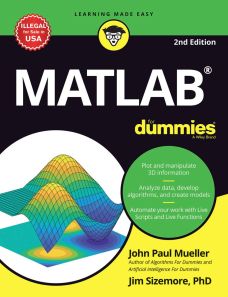MATLAB For Dummies, 2ed
ISBN: 9789357460354
496 pages
For more information write to us at: acadmktg@wiley.com

Description
MATLAB is a high-level language and problem-solving environment used across all the STEM (science, technology, engineering, and mathematics) fields and commonly adopted for use in colleges around the world. The computational tools within the software are powerful and can be easy to use with experience, but a comprehensive and easy-to-use manual is an essential introduction. MATLAB For Dummies is a painless introduction to one of the most popular software tools for numerical computation, visualization, and programming and will cover everything a student or new professional would need to get started.
Introduction
About This Book
Foolish Assumptions
Icons Used in This Book
Beyond the Book
Where to Go from Here
Part 1: Getting Started With MATLAB
Chapter 1: Introducing MATLAB and Its Many Uses
- Putting MATLAB in Its Place
- Understanding how MATLAB relates to a Turing machine
- Using MATLAB as more than a calculator
- Determining why you need MATLAB
- Discovering Who Uses MATLAB for Real-World Tasks
- Knowing How to Get the Most from MATLAB
- Getting the basic computer skills
- Defining the math requirements
- Applying what you know about other procedural languages
- Understanding how this book will help you
- Getting Over the Learning Curve
Chapter 2: Starting Your Copy of MATLAB
- Installing MATLAB
- Discovering which platforms MATLAB supports
- Getting your copy of MATLAB
- Performing the installation
- Activating the product
- Meeting the MATLAB Interface
- Starting MATLAB for the first time
- Considering the default Toolstrip tabs
- Working with the Quick Access toolbar (QAT)
- Employing the Command Window
- Getting additional help with MATLAB
- Using the Current Folder toolbar
- Viewing the Current Folder window
- Changing the MATLAB layout
Chapter 3: Interacting with MATLAB
- Using MATLAB as a Calculator
- Entering information at the prompt
- Entering a formula
- Copying and pasting formulas
- Changing the Command Window formatting
- Suppressing Command Window output
- Understanding the MATLAB Math Syntax
- Adding, subtracting, multiplying, and dividing
- Working with exponents
- Organizing Your Storage Locker
- Using ans -- the default storage locker
- Creating your own storage lockers
- Operating MATLAB as More Than a Calculator
- Learning the truth
- Using the built-in functions
- Accessing the function browser
- Recovering from Mistakes
- Understanding the MATLAB error messages
- Stopping MATLAB when it hangs
Chapter 4: Starting, Storing

